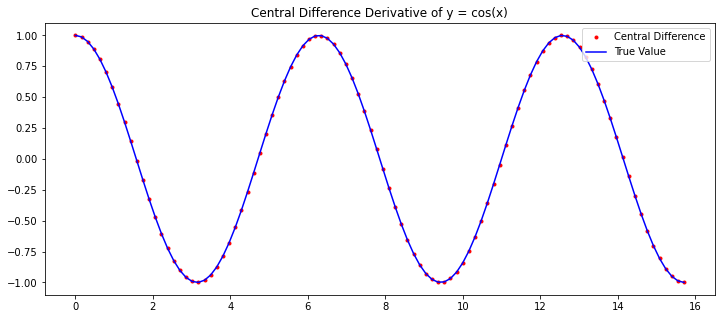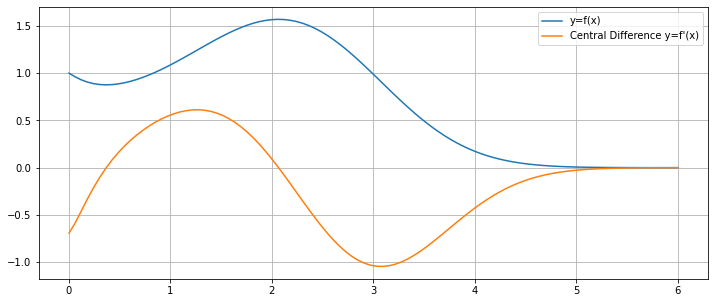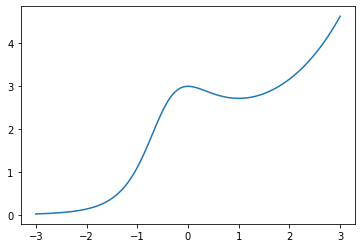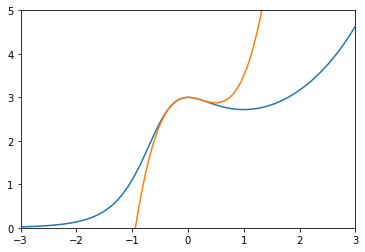Numerical Differentiation
import numpy as np
import matplotlib.pyplot as plt
Derivative
The derivative of a function $f(x)$ at $x=a$ is the limit
$$ f'(a) = \lim_{h \to 0} \frac{f(a+h) - f(a)}{h} $$
Difference Formulas
There are 3 main difference formulas for numerically approximating derivatives.
The forward difference formula with step size $h$ is
$$ f'(a) \approx \frac{f(a + h) - f(a)}{h} $$
The backward difference formula with step size $h$ is
$$ f'(a) \approx \frac{f(a) - f(a - h)}{h} $$
The central difference formula with step size $h$ is the average of the forward and backwards difference formulas
$$ f'(a) \approx \frac{1}{2} \left( \frac{f(a + h) - f(a)}{h} + \frac{f(a) - f(a - h)}{h} \right) = \frac{f(a + h) - f(a - h)}{2h} $$
Implementation
Let's write a function called derivative which takes input parameters f, a, method and h (with default values method='central' and h=0.01) and returns the corresponding difference formula for $f'(a)$ with step size $h$.
def derivative(f,a,method='central',h=0.01):
'''Compute the difference formula for f'(a) with step size h.
Parameters
----------
f : function
Vectorized function of one variable
a : number
Compute derivative at x = a
method : string
Difference formula: 'forward', 'backward' or 'central'
h : number
Step size in difference formula
Returns
-------
float
Difference formula:
central: f(a+h) - f(a-h))/2h
forward: f(a+h) - f(a))/h
backward: f(a) - f(a-h))/h
'''
if method == 'central':
return (f(a + h) - f(a - h))/(2*h)
elif method == 'forward':
return (f(a + h) - f(a))/h
elif method == 'backward':
return (f(a) - f(a - h))/h
else:
raise ValueError("Method must be 'central', 'forward' or 'backward'.")
Let's test our function on some simple functions. For example, we know
$$ \left. \frac{d}{dx} \left( \cos x \right) \, \right|_{x=0} = -\sin(0) = 0 $$
and we compute
derivative(np.cos,0)
0.0
derivative(np.cos,0,method='forward',h=1e-8)
0.0
We also know
$$ \left. \frac{d}{dx} \left( e^x \right) \, \right|_{x=0} = e^0 = 1 $$
and we compute
derivative(np.exp,0,h=0.0001)
1.0000000016668897
derivative(np.exp,0,method='backward',h=0.0001)
0.9999500016666385
Notice that our function can take an array of inputs for $a$ and return the derivatives for each $a$ value. For example, we can plot the derivative of $\sin(x)$:
x = np.linspace(0,5*np.pi,100)
dydx = derivative(np.sin,x)
dYdx = np.cos(x)
plt.figure(figsize=(12,5))
plt.plot(x,dydx,'r.',label='Central Difference')
plt.plot(x,dYdx,'b',label='True Value')
plt.title('Central Difference Derivative of y = cos(x)')
plt.legend(loc='best')
plt.show()

Let's compute and plot the derivative of a complicated function
$$ y=\left(\frac{4x^2+2x+1}{x+2e^x}\right)^x $$
x = np.linspace(0,6,100)
f = lambda x: ((4*x**2 + 2*x + 1)/(x + 2*np.exp(x)))**x
y = f(x)
dydx = derivative(f,x)
plt.figure(figsize=(12,5))
plt.plot(x,y,label='y=f(x)')
plt.plot(x,dydx,label="Central Difference y=f'(x)")
plt.legend()
plt.grid(True)
plt.show()

Error Formulas
Natural questions arise: how good are the approximations given by the forward, backwards and central difference formulas? We derive the error formulas from Taylor's Theorem.
Theorem. The degree $n$ Taylor polynomial of $f(x)$ at $x=a$ with remainder term is
$$ f(x) = f(a) + f'(a)(x - a) + \frac{f''(a)}{2}(x-a)^2 + \cdots + \frac{f^{(n)}(a)}{n!}(x-a)^n + \frac{f^{(n+1)}(c)}{(n+1)!}(x-a)^{n+1} $$
for some value $c$ between $x$ and $a$.
Theorem. The forward difference formula error is
$$ \left| \, \frac{f(a+h) - f(a)}{h} - f'(a) \, \right| \leq \frac{hK_2}{2} $$
where $\left| \, f''(x) \, \right| \leq K_2$ for all $x \in [a,a+h]$. The same error fomula holds for the backward difference formula.
Proof. Look at the degree 1 Taylor formula:
$$ f(x) = f(a) + f'(a)(x-a) + \frac{f''(c)}{2}(x-a)^{2} $$
Let $x = a+h$ and manipulate the formula
\begin{align} f(a+h) &= f(a) + f'(a)h + \frac{f''(c)}{2}h^{2} \\ f(a+h) - f(a) &= f'(a)h + \frac{f''(c)}{2}h^{2} \\ \frac{f(a+h) - f(a)}{h} &= f'(a) + \frac{f''(c)}{2}h \\ \frac{f(a+h) - f(a)}{h} - f'(a) &= \frac{f''(c)}{2}h \end{align}
Let $K_2$ such that $\left| \, f''(x) \, \right| \leq K_2$ for all $x \in [a,a+h]$ and we see the result.
Theorem. The central difference formula error is:
$$ \left| \frac{f(a+h) - f(a-h)}{2h} - f'(a) \right| \leq \frac{h^2K_3}{6} $$
where $|f'''(x)| \leq K_3$ for all $x \in [a-h,a+h]$.
Proof. Look at the Taylor polynomial of degree 2:
$$ f(x) = f(a) + f'(a)(x-a) + \frac{f''(a)}{2}(x-a)^2 + \frac{f'''(c)}{6}(x-a)^{3} $$
Let $x = a + h$ and also $x = a - h$ and write:
\begin{align} f(a+h) &= f(a) + f'(a)h + \frac{f''(a)}{2}h^2 + \frac{f'''(c_1)}{6}h^{3} \\ f(a-h) &= f(a) - f'(a)h + \frac{f''(a)}{2}h^2 - \frac{f'''(c_2)}{6}h^{3} \\ f(a+h) - f(a-h) &= 2 f'(a)h + \frac{f'''(c_1)}{6}h^{3} + \frac{f'''(c_2)}{6}h^{3} \\ \frac{f(a+h) - f(a-h)}{2h} - f'(a) &= \frac{f'''(c_1) + f'''(c_2)}{12}h^{2} \end{align}
Notice that $f'''(x)$ is continuous (by assumption) and $(f'''(c_1) + f'''(c_2))/2$ is between $f'''(c_1)$ and $f'''(c_2)$ and so there exists some $c$ between $c_1$ and $c_2$ such that
$$ f'''(c) = \frac{f'''(c_1) + f'''(c_2)}{2} $$
by the Intermediate Value Theorem. Let $K_3$ such that $\left| \, f'''(x) \, \right| \leq K_3$ for all $x \in [a-h,a+h]$ and we see the result.
scipy.misc.derivative
The SciPy function scipy.misc.derivative computes derivatives using the central difference formula.
from scipy.misc import derivative
x = np.arange(0,5)
derivative(np.exp,x,dx=0.1)
array([ 1.0016675 , 2.72281456, 7.40137735, 20.11902956, 54.68919246])
Higher Order Derivatives
Under construction
Examples
Taylor series
Let's plot the Taylor polynomial $T_3(x)$ of degree 3 centered at $x=0$ for $f(x) = \frac{3e^x}{x^2 + x + 1}$ over the interval $x \in [-3,3]$. First, let's plot the graph $y=f(x)$:
x = np.linspace(-3,3,100)
f = lambda x: 3*np.exp(x) / (x**2 + x + 1)
y = f(x)
plt.plot(x,y);
plt.show()

Let's compute the coefficients $a_n = \frac{f^{(n)}(0)}{n!}$ for $n=0,1,2,3$:
a0 = f(0)
a1 = derivative(f,0,dx=0.001,n=1)
a2 = derivative(f,0,dx=0.001,n=2) / 2
a3 = derivative(f,0,dx=0.001,n=3,order=5) / 6
# The parameter order specifies the number of points to use
# The value order must be odd and at least n + 1
print(a0,a1,a2,a3)
3.0 1.9999983891239026e-06 -1.50000037502096 1.9999920608526622
Finally, let's plot $f(x)$ and $T_3(x)$ together:
T3 = a0 + a1*x + a2*x**2 + a3*x**3
plt.plot(x,y,x,T3), plt.xlim([-3,3]), plt.ylim([0,5]);
plt.show()

Arc length
Write a function called arc_length which takes parameters f, a, b and N and returns an approximation of the arc length of $f(x)$ from $a$ to $b$
$$ L \approx \int_a^b \sqrt{ 1 + \left( f'(x) \right)^2 } dx $$
The function uses the trapezoid rule (scipy.integrate.trapz) to estimate the integral using $N+1$ equally spaced points from $a$ to $b$ (with default value $N=100$), and the central difference formula to approximate $f'(x)$ with step size $h=(b-a)/N$. Note that we can't use the central difference formula at the endpoints because they use $x$ values outside the interval $[a,b]$ and our function may not be defined there.
import scipy.integrate as spi
def arc_length(f,a,b,N=100):
'''Approximate the arc length of y=f(x) from x=a to x=b.
Parameters
----------
f : function
Vectorized function of one variable
a,b : numbers
Limits of the interval [a,b]
N : number
Subintervals in trapezoid method
Returns
-------
float
Trapezoid method approximation of the integral
\int_a^b \sqrt{1 + (f'(x))^2} dx
representing the arc length of y=f(x) from x=a to x=b.
'''
x = np.linspace(a,b,N+1)
y = f(x)
# Compute central difference formula for x_k for 0 < k < N
h = (b-a)/N
x_interior = x[1:-1]
df_interior = (f(x_interior + h) - f(x_interior - h))/(2*h)
# Use forward/backward difference formula at the endpoints
df_a = (f(a + h) - f(a))/h
df_b = (f(b) - f(b - h))/h
df = np.hstack([[df_a],df_interior,[df_b]])
# Compute values of the integrand in arc length formula
y = np.sqrt(1 + df**2)
# Compute the integral
L = spi.trapz(y,x)
return L
Let's test our function with input where we know the exact output. For example, the arc length of $f(x)=x$ from $a=0$ to $b=1$ is $L=\sqrt{2}$ and we compute
f = lambda x: x
a = 0; b = 1;
arc_length(f,a,b)
1.4142135623730954
and compare with the exact value
np.sqrt(2)
1.4142135623730951
The arc length of $f(x)=\sqrt{1 - x^2}$ from $a=0$ to $b=\frac{1}{\sqrt{2}}$ is $L=\frac{\pi}{4}$ and we compute
f = lambda x: np.sqrt(1 - x**2)
a = 0; b = 1/np.sqrt(2);
arc_length(f,a,b)
0.7853899139845573
and compare to the exact value
np.pi/4
0.7853981633974483
The arc length of $f(x)=\frac{2x^{3/2}}{3}$ from $a=0$ to $b=1$ is $L = \frac{2}{3}\left( 2^{3/2} - 1 \right)$ and we compute
f = lambda x: 2*(x**(3/2))/3
a = 0; b = 1; N = 10**5;
arc_length(f,a,b)
1.2189308934829772
and compare to the exact value
(2/3)*(2**(3/2) - 1)
1.2189514164974602
Exercises
Exercise 1. Use derivative to compute values and then plot the derivative $f'(x)$ of the function
$$ f(x) = \frac{7x^3-5x+1}{2x^4+x^2+1} \ , \ x \in [-5,5] $$
Compute the derivative of $f(x)$ by hand (using the quotient rule), plot the formula for $f'(x)$ and compare to the numerical approximation above.
Exercise 2. Plot the Taylor polynomial $T_4(x)$ of degree 4 centered at $x=0$ of the function
$$ f(x) = \cos(x) + \sin(2x) $$
over the interval $x \in [-\pi,\pi]$.